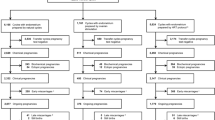Abstract
Purpose
This study aimed to clarify the risks of adverse pregnancy outcomes in patients who conceive singletons after frozen embryo transfer (FET) during a hormone replacement cycle and their offspring.
Methods
A retrospective cohort study was conducted in patients who conceived after FET, based on the Japanese-assisted reproductive technology registry for 2013. The perinatal outcomes in cases with live-born singletons achieved through natural ovulatory cycle FET (NC-FET) (n = 6287) or hormone replacement cycle FET (HRC-FET) (n = 10,235) were compared. Multiple logistic regression analyses were performed to determine the potential confounding factors.
Results
The frequencies of macrosomia (1.1% in NC-FET and 1.4% in HRC-FET; P = 0.058) were comparable between patients after NC-FET and HRC-FET. The proportions of post-term delivery (0.2% in NC-FET and 1.3% in HRC-FET; P < 0.001) and Cesarean section (33.6% in NC-FET and 43.0% in HRC-FET; P < 0.001) were higher in patients after HRC-FET than in patients after NC-FET. The risks of post-term delivery (adjusted odds ratio (AOR) 5.68, 95% confidence interval (CI) 3.30–9.80) and Cesarean section (AOR 1.64, 95% CI 1.52–1.76) were also higher in patients after HRC-FET than in patients after NC-FET.
Conclusions
Patients who conceived singletons after HRC-FET were at increased risk of post-term delivery and Cesarean section compared with those who conceived after NC-FET.



Similar content being viewed by others

References
Gera PS, Tatpati LL, Allemand MC, Wentworth MA, Coddington CC. Ovarian hyperstimulation syndrome: steps to maximize success and minimize effect for assisted reproductive outcome. Fertil Steril. 2010;94:173–8.
Takeshima K, Jwa SC, Saito H, Nakaza A, Kuwahara A, Ishihara O, et al. Impact of single embryo transfer policy on perinatal outcomes in fresh and frozen cycles-analysis of the Japanese Assisted Reproduction Technology registry between 2007 and 2012. Fertil Steril. 2016;105:337–46.
Groenewoud ER, Cantineau AE, Kollen BJ, Macklon NS, Cohlen BJ. What is the optimal means of preparing the endometrium in frozen-thawed embryo transfer cycles? A systematic review and meta-analysis. Hum Reprod Update. 2013;19:458–70.
Kaser DJ, Melamed A, Bormann CL, Myers DE, Missmer SA, Walsh BW, et al. Cryopreserved embryo transfer is an independent risk factor for placenta accrete. Fertil Steril. 2015;103:1176–84.
Ishihara O, Araki R, Kuwahara A, Itakura A, Saito H, Adamson GD. Impact of frozen-thawed single-blastocyst transfer on maternal and neonatal outcome: an analysis of 277,042 single-embryo transfer cycles from 2008 to 2010 in Japan. Fertil Steril. 2014;101:128–33.
Opdahl S, Henningsen AA, Tiitinen A, Bergh C, Pinborg A, Romundstad PR, et al. Risk of hypertensive disorders in pregnancies following assisted reproductive technology: a cohort study from the CoNARTaS group. Hum Reprod. 2015;30:1724–31.
Wennerholm UB, Henningsen AK, Romundstad LB, Bergh C, Pinborg A, Skjaerven R, et al. Perinatal outcomes of children born after frozen-thawed embryo transfer: a Nordic cohort study from the CoNARTaS group. Hum Reprod. 2013;28:2545–53.
Nastri CO, Lensen SF, Gibreel A, Raine-Fenning N, Ferriani RA, Bhattacharya S, et al. Endometrial injury in women undergoing assisted reproductive techniques. Cochrane Database Syst Rev. 2015;3:CD009517.
Jauniaux E, Jurkovic D. Placenta accreta: pathogenesis of a 20th century iatrogenic uterine disease. Placenta. 2012;33:244–51.
Imudia AN, Awonuga AO, Doyle JO, Kaimal AJ, Wright DL, Toth TL, et al. Peak serum estradiol level during controlled ovarian hyperstimulation is associated with increased risk of small for gestational age and preeclampsia in singleton pregnancies after in vitro fertilization. Fertil Steril. 2012;97:1374–9.
Roos N, Kieler H, Sahlin L, Ekman-Ordeberg G, Falconer H, Stephansson O. Risk of adverse pregnancy outcomes in women with polycystic ovary syndrome: population based cohort study. BMJ. 2011;343:d6309.
Givens CR, Markun LC, Ryan IP, Chenette PE, Herbert CM, Schriock ED. Outcomes of natural cycles versus programmed cycles for 1677 frozen-thawed embryo transfers. Reprod Biomed Online. 2009;19:380–4.
Zheng Y, Li Z, Xiong M, Luo T, Dong X, Huang B, et al. Hormonal replacement treatment improves clinical pregnancy in frozen-thawed embryos transfer cycles: a retrospective cohort study. Am J Transl Res. 2014;6:85–90.
Nakashima A, Araki R, Tani H, Ishihara O, Kuwahara A, Irahara M, et al. Implications of assisted reproductive technologies on term singleton birth weight: an analysis of 25,777 children in the national assisted reproduction registry of Japan. Fertil Steril. 2013;99:450–5.
Itabashi K, Fujimura M, Kusuda S, Tamura M, Hayashi T, Takahashi T, et al. New standard of average size and weight of newborn in Japan. Jap J Pediat. 2010;114:1271–93 (in Japanese).
Practice ACOG. Bulletin. Clinical management guidelines for obstetricians-gynecologists. Number 55, September 2004 (replaces practice pattern number 6, October 1997). Management of postterm pregnancy. Obstet Gynecol. 2004;104:639–46.
American College of Obstetricians and Gynecologists. Practice bulletin no. 146: management of late-term and postterm pregnancies. Obstet Gynecol. 2014;124:390–6.
Tummon I, Gavrilova-Jordan L, Allemand MC, Session D. Polycystic ovaries and ovarian hyperstimulation syndrome: a systematic review*. Acta Obstet Gynecol Scand. 2005;84:611–6.
Acknowledgements
We would like to thank all of the Japanese fertility clinics for reporting the data and the JSOG for kindly providing the data.
Authors’ roles
K.S. and H.S. initiated and planned the study. K.S., K.M., K.Y., A.K., E.I., and M.M. analyzed the data. K.S., K.M., A.K., M.F., T.I., T.S., T.K., and H.S. interpreted the results. K.S. and K.M. drafted the manuscript. All of the authors critically reviewed and approved the manuscript.
Author information
Authors and Affiliations
Corresponding author
Ethics declarations
This study was approved by the Institutional Review Board and the registration and research subcommittee of the Japan Society of Obstetrics and Gynecology (JSOG) Ethics Committee.
Funding
This study was supported by a Grant from the Japan Agency for Medical Research and Development (No. 15gk0110001h0103). The sponsor had no role in the study design; in the collection, analysis, or interpretation of data; in the writing of the report; or in the decision to submit the article for publication.
Conflict of interest
The authors declare that they have no conflict of interest.
Rights and permissions
About this article
Cite this article
Saito, K., Miyado, K., Yamatoya, K. et al. Increased incidence of post-term delivery and Cesarean section after frozen-thawed embryo transfer during a hormone replacement cycle. J Assist Reprod Genet 34, 465–470 (2017). https://doi.org/10.1007/s10815-017-0869-7
Received:
Accepted:
Published:
Issue Date:
DOI: https://doi.org/10.1007/s10815-017-0869-7



